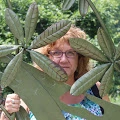I will start with the four show-offs.
These are the ones everyone notices by road or stream.
My next post will be of the quiet little beauties that may be overlooked.
This stand of New York Ironweed/ Veronica novebaracensis is by a road I travel often.

I look for it every summer and fall. It has gotten bigger over the years.

It is over six feet tall. When the sun hits it, it can stop traffic.
Joe Pye weed/ Eupartorium maculatum is another tall beauty.

Legend has it that it is named for an Indian “Joe Pye” who used it to cure fevers.

This stand is huge and also beside a familiar road.
I was lucky to find this Cardinal flower/Lobelia cardinalis. This one is named for being the color of Roman Catholic cardinal robes.

It was tucked up under a bridge. This one has been over-picked and is harder to find.

The last is probably the most familiar, Goldenrod/ Solidago.

I was hesitant to pick a species name for this one without a closer look.
It is a supplier of mountain sunshine along roads and fences.

So here are the “big four.” Next will come the “hardly noticed” mountain wildflowers.
Flower in the Wild


















































 I gave it back after the photo.
I gave it back after the photo.

